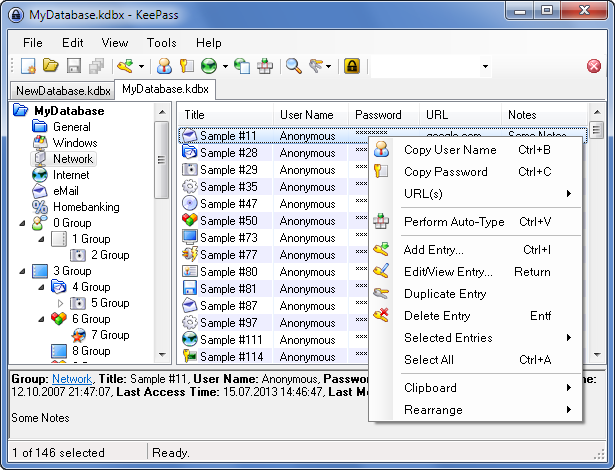 Dominik Reichl heeft versie 2.48 van KeePass Password Safe uitgebracht. Met deze opensource-wachtwoordmanager kunnen accounts worden opgeslagen, inclusief de bijbehorende gegevens, zoals gebruikersnaam, wachtwoord en url. Alle gegevens worden veilig in een met het Rijndael-algoritme versleutelde database opgeslagen. Verder kan het programma automatisch wachtwoorden genereren en lijsten im- en exporteren. Door het toevoegen van dit taalbestand kan het programma ook in het Nederlands worden gebruikt.
Dominik Reichl heeft versie 2.48 van KeePass Password Safe uitgebracht. Met deze opensource-wachtwoordmanager kunnen accounts worden opgeslagen, inclusief de bijbehorende gegevens, zoals gebruikersnaam, wachtwoord en url. Alle gegevens worden veilig in een met het Rijndael-algoritme versleutelde database opgeslagen. Verder kan het programma automatisch wachtwoorden genereren en lijsten im- en exporteren. Door het toevoegen van dit taalbestand kan het programma ook in het Nederlands worden gebruikt.
Van KeePass Password Safe bestaan twee verschillende uitvoeringen die beide actief worden ontwikkeld. Versie 1.x is niet afhankelijk van andere software en werkt alleen onder Windows. Versie 2 maakt intern gebruik van xml en heeft verder minimaal versie 2.0 van het .Net Framework nodig of, als het programma onder Linux, macOS of FreeBSD wordt gebruikt, van Mono versie 2.6 of hoger. Een volledig overzicht van de verschillen tussen versie 1 en 2 is op deze pagina te vinden. Hieronder staat de changelog van deze uitgave.
New Features:Improvements:
- New KDBX 4.1 file format, which supports various new features (listed below).
- Added support for group tags (KDBX 4.1).
- In the entry/group dialogs, there now is a button to show a menu for adding/removing existing tags.
- If an entry/group inherits a tag from a parent group, a link is displayed in the entry/group dialog to show the parent groups and their tags.
- Added option in the entry dialog for disabling/enabling the password quality estimation for the current entry (KDBX 4.1).
- If the password quality estimation is disabled for an entry, the entry is now excluded from password quality reports (menu 'Find' → 'Password Quality').
- When moving an entry/group into a different group (e.g. into the recycle bin), the previous parent group is remembered now (KDBX 4.1, not enforcing).
- Added command 'Move to Previous Parent Group' (in the 'Rearrange' popup menu; if the command will move all selected entries/groups out of the recycle bin, a '(Restore)' suffix is appended to the command name; if at least one entry/group will be moved into/within the recycle bin, a confirmation dialog is displayed).
- Renaming a list view item (if supported, e.g. a file attached to an entry) can now be initiated by pressing the F2 key.
- Each custom icon may now have a name, and its last modification time is remembered (KDBX 4.1).
- In the icon picker dialog, a custom icon can now be renamed (click on an already selected name or press the F2 key).
- In the icon picker dialog, the dimensions and the size of a custom icon are now displayed in a tooltip.
- The UUID and the deletion time of a deleted custom icon are remembered now, and this information is used in order to delete the custom icon during a synchronization (if the last modification time is older than the deletion time).
- Added built-in URL override for associating the 'ssh' URL scheme with 'SSH.exe' (OpenSSH, included in Windows 10; activatable/deactivatable in 'Tools' → 'Options' → tab 'Integration' → button 'URL Overrides').
- Added support for loading images with Exif orientation tags.
- Enhanced the LastPass import module to support CSV files created by the latest versions.
- Enhanced the nPassword import module to import group tags.
- The last modification time of a database-specific custom data item (by a plugin/port) is now saved (KDBX 4.1).
- When synchronizing databases, database-specific custom data items (by plugins/ports) are now merged based on their last modification times.
- Added support for loading KDBX 4 files created by other applications that do not perform a binary content deduplication.
- Added workaround for .NET/Windows
TopMost/WS_EX_TOPMOSTdesynchronization bug.Bugfixes:
- Various user interface improvements in the group dialog (moved the notes box to the first tab page, moved the auto-type behavior option to the auto-type tab, ...).
- Tags are sorted naturally now.
- Improved tag handling performance.
- Various user interface improvements in the icon picker dialog.
- The temporary icon that represents multiple icons (when editing multiple entries at once) is now named '(Multiple values)'.
- Improved custom icon handling performance.
- The placeholders
{HMACOTP}and{TIMEOTP}now automatically add padding to shared secrets in Base32 encoding, if necessary.- Improved error handling of the placeholders
{HMACOTP}and{TIMEOTP}.- Internal data viewer/editor: '*.asc', '*.tab' and '*.tsv' files are now treated as text files by default.
- The internal data viewer now does not try to display non-HTML files using the web browser control anymore.
- Improved error handling of the Bitwarden JSON and nPassword NPW import modules.
- Improved merging of custom data items (by plugins/ports) in the KDBX file header.
- Improved image hashing.
- Improved version display in the 'About' dialog.
- Installer: improved file overwriting.
- On 64-bit operating systems, the registry value for the setup option 'Optimize KeePass start-up performance' is now created in the 64-bit view of the registry.
- ShInstUtil now fully supports Unicode.
- Various UI text improvements.
- Various code optimizations.
- Minor other improvements.
- The command 'Delete Unused Custom Icons' does not delete icons anymore that are still used by history entries.


:strip_exif()/i/2007293302.png?f=thumbmedium)